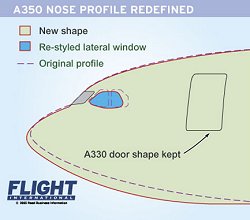 Airbus says that recent aerodynamic tweaks to the A350’s upper wing surface and flap-track fairings are the prime drivers behind the increased cruise speed it has achieved with its latest design iteration of the twinjet.
Airbus says that recent aerodynamic tweaks to the A350’s upper wing surface and flap-track fairings are the prime drivers behind the increased cruise speed it has achieved with its latest design iteration of the twinjet.
The company has simplified the flightdeck window design as part of changes incorporated into the reprofiled nose section to accommodate a larger flight-crew rest compartment (FCRC).
“Using the latest computational fluid dynamics [CFD] technology, which we have verified in the windtunnel, we have reprofiled the mid-section of the upper surface of the wing,” says A350 chief engineer Dougie Hunter. “We’ve also reshaped the flap-track fairings and reduced their length using CFD analysis.”
Hunter says the changes “delay the onset of drag rise and push long-range cruise speed up from Mach 0.82 to 0.83, and economic cruise speed to Mach 0.84”.
The A350 now sports a deeper nose section to enable the lower deck FCRC to provide 1.75m (5.7ft) of stand-up height and, as part of the changes, Airbus has simplified the flightdeck window arrangement. “We’ve gone from four lateral windows to two – aerodynamics were the driver as it nets a 0.25% drag reduction,” says Hunter.
The reprofiling has enabled Airbus to simplify the nose-section’s structure, and to drop earlier plans to fit a longer nose-gear leg. “We had adopted the longer gear to give the A350 a level standing position on the ground, but the reprofiling enables us to have a lower attachment point to achieve the level attitude with existing leg length, although the gear will be new,” says Hunter.
The next key point in the A350’s development is what Airbus calls “Milestone 5” in the first quarter of 2006, which is the design freeze. Airbus has selected incumbent A330/A340 supplier Messier-Dowty to provide the new main landing gear for the A350, and will select the auxiliary power unit by February.
■ Oneworld alliance member Finnair’s long-haul fleet renewal will be based on the Airbus A350-900, which the carrier plans to configure with 314 seats. Finnair is to acquire nine of the type, with options on four more, along with at least three 303-seat Airbus A340-300Es to replace its Boeing MD-11 aircraft.
MAX KINGSLEY-JONES/TOULOUSE
Source: Flight International



















